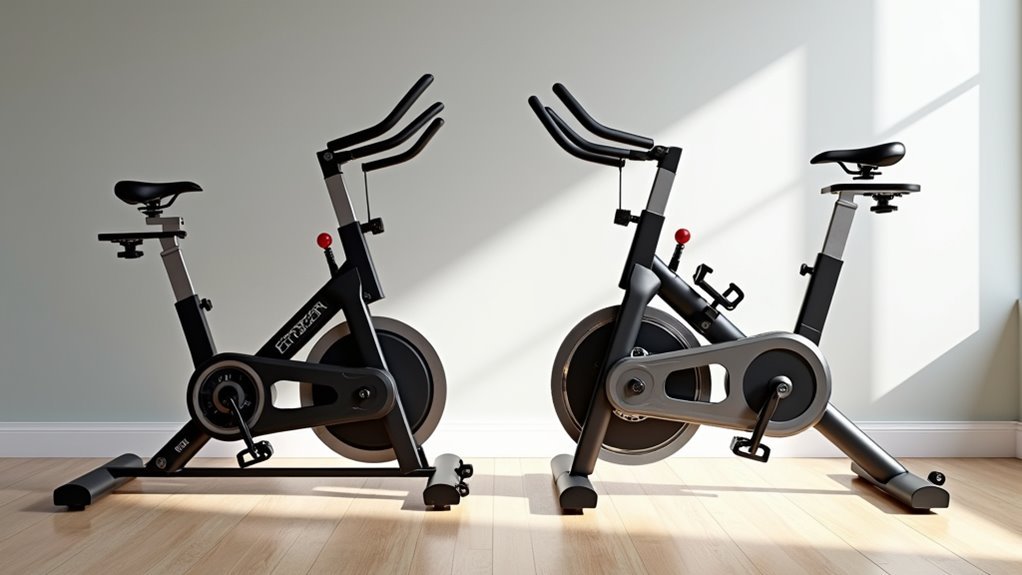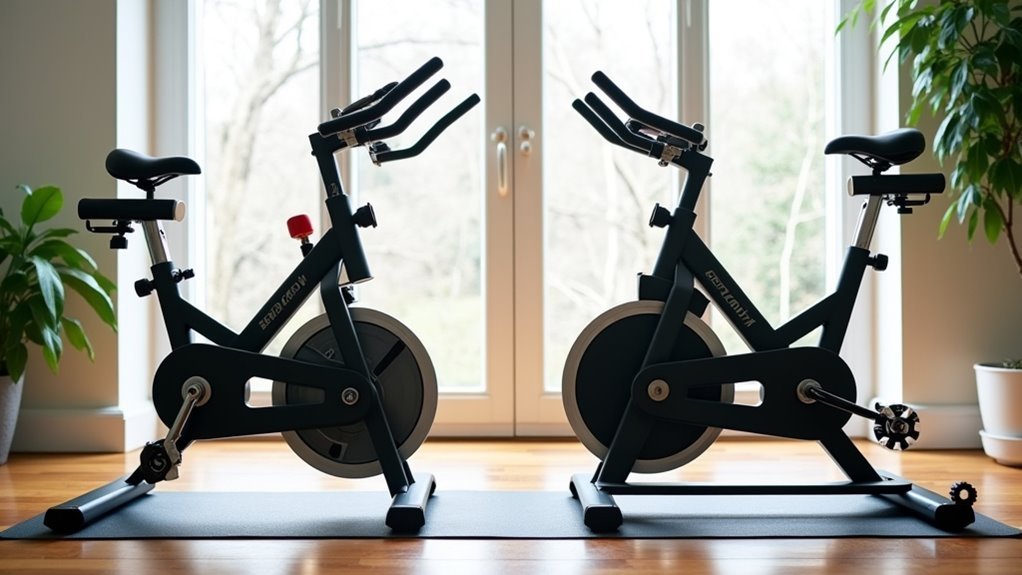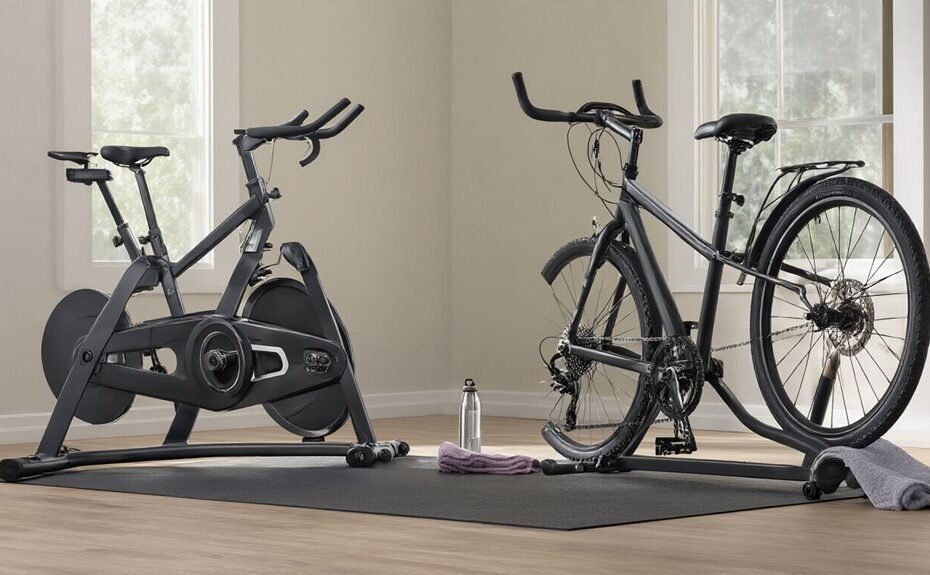Noise levels can make or break an exercise routine, especially for those sharing living spaces. When it comes to exercise bikes, the drive system greatly impacts how disruptive your workout might be. Belt drives operate with a smooth, barely audible hum, while chain drives tend to click and clatter—much like outdoor bicycles. The difference becomes particularly noticeable during intense sessions or early morning workouts when others might still be sleeping.
Understanding Noise Levels in Exercise Bikes
Why does noise matter so much when selecting an exercise bike for your home? The difference between a peaceful workout and a disruptive one often comes down to your bike’s drive system.
Belt drive systems offer an incredibly quiet ride, producing just a soft whirring that won’t disturb household members or neighbors. Chain drives, while reminiscent of outdoor cycling, create more noticeable clicking sounds that increase without proper maintenance.
Your workout experience greatly depends on noise level—a quieter bike helps maintain focus and enjoyment. Additionally, when considering your options, it’s important to note that using a recumbent bike can provide a comfortable and effective workout while minimizing stress on your joints.
When choosing a resistance system, remember that belt drives generally provide a smoother, more silent experience, while chain drives might require regular lubrication to keep noise at bay.
How Belt Drive Systems Work for Quiet Operation
Belt drive systems represent the gold standard for noise reduction in modern exercise bikes through their ingenious design of toothed synchronous rubber belts engaging directly with the flywheel.
The carbon fiber or polyurethane construction eliminates the metal-on-metal contact points found in chain drives, drastically reducing operational noise to nearly imperceptible levels.
Unlike their chain-driven counterparts, these systems require minimal maintenance and provide years of whisper-quiet performance, making them ideal for apartment dwellers or early morning workout enthusiasts.
Belt Mechanism Fundamentals
The quiet revolution in exercise bike engineering starts with the design of the belt drive system. Unlike traditional chain drives that click and clank, belt drives utilize toothed synchronous rubber components that fit precisely into the flywheel and pedal mechanisms. This creates a smooth, nearly silent cycling experience with just a faint whirring sound during operation.
What’s really great about these systems is how the high-tension straps efficiently transfer power while minimizing vibration.
There’s virtually no physical contact like you’d find in other systems, and unlike chain drives, they don’t need constant maintenance or greasing to stay quiet. For home workouts, you can’t beat their unobtrusive performance.
Noise Reduction Technology
Modern noise reduction technology fundamentally changes how we experience home workouts.
Belt drive systems deliver a virtually silent operation compared to their chain drive counterparts—a vital feature for those in noise-sensitive environments like apartments or early-morning exercisers.
The magic happens through the toothed synchronous rubber belt’s minimal friction design, coupled with magnetic resistance that eliminates traditional contact points.
Without metal-on-metal contact, those annoying clicks and clunks disappear.
What’s more, belt drives don’t need regular lubrication, reducing maintenance-related noise long-term.
For those seeking a quiet workout experience without sacrificing performance, belt drive technology represents the gold standard of exercise bike engineering.
Chain Drive Mechanics and Sound Production

Chain drives operate similarly to traditional bicycle mechanisms, with metal links rotating over sprockets to create forward motion.
The distinctive clicking sound they produce is actually part of their mechanical design, as the chain engages with each sprocket tooth during rotation.
While this noise is perfectly normal, factors like improper tension, lack of lubrication, or worn components can amplify the sound beyond what’s typical for chain-driven exercise bikes.
How Chains Work
Many exercise enthusiasts don’t realize that traditional chain drive systems operate on remarkably similar principles to outdoor bicycles. The chain mechanism directly impacts your workout experience, transferring power while creating that familiar clicking noise that some find motivating, others distracting.
- Chain drives use metal links rotating over sprockets to power the flywheel.
- They produce a distinctive clicking sound that mimics outdoor cycling.
- Unlike belt drives, chains offer consistent power transfer without elastic sliding.
- Regular maintenance (lubrication and tightening) is essential to minimize noise.
- Chain guards can help dampen sound for a quieter workout environment.
Without proper maintenance, chain noise can actually increase over time, affecting both your experience and others nearby.
Noise Level Factors
The persistent clicking and whirring sounds from an exercise bike can transform a peaceful morning workout into an acoustic nuisance for the entire household.
Chain drive systems are naturally noisier than their belt-driven counterparts, producing a distinctive clicking as metal links rotate over sprockets. This noise level increases when maintenance is neglected – loose chains or inadequate lubrication can turn a subtle whir into an irritating grind during resistance adjustments.
While adding chain guards helps dampen sound, even well-maintained chain drives aren’t almost silent like belt alternatives.
For noise-sensitive environments or early morning workouts, these maintenance requirements and inherent sound characteristics become important factors in workout preferences.
Key Factors Affecting Exercise Bike Noise Levels
When selecting an exercise bike for a quiet home workout environment, understanding the factors that influence noise levels becomes crucial.
Belt drive systems offer a smooth ride with minimal noise, while chain drives produce that familiar bike-like clicking sound that some might find distracting during intense workouts.
- Belt drives use rubber materials that naturally dampen sound during operation.
- Chain drives require regular maintenance and lubrication to keep noise levels down.
- Higher pedaling speed typically increases noise, especially with chain systems.
- The contact area between drive mechanism and flywheel affects vibration intensity.
- Proper maintenance guarantees both drive types operate at their quietest potential. Additionally, choosing a model like the Bells of Steel Blitz Air Bike 2.0 can enhance your workout experience while keeping noise levels low.
Best Practices for Maintaining a Quiet Exercise Bike

Most exercise bikes eventually develop irritating noises without proper care, making regular maintenance an essential practice for home fitness enthusiasts.
For chain drive bikes, regular tightening and lubrication prevent those annoying clicks that can disrupt your workout environment. Belt drive systems, while naturally quieter, still require periodic inspection for wear and proper alignment.
Both types benefit from routine cleaning to remove debris that causes friction and noise. Think of maintenance like tuning a musical instrument—proper tension is key!
A quiet exercise bike not only improves your spin sessions but also extends the lifespan of your investment. It’s probably the difference between a peaceful workout and an irritating one. Regular upkeep, including quick safety checks, enhances bike performance and prevents small problems from turning into costly repairs.
Choosing the Right Drive System for Your Home Environment
Now that we’ve covered maintenance basics, selecting the appropriate drive system deserves careful consideration for anyone setting up a home gym.
When choosing between belt and chain drives for indoor cycling, several factors affect your riding experience:
- Belt drives offer whisper-quiet operation ideal for noise-sensitive environments
- Chain drives, while durable, produce clicking sounds that might disturb household members
- Low maintenance belt systems require minimal upkeep compared to regularly lubricated chain drives
- Belt-driven bikes provide a smoother workout without the mechanical interruptions
- The initial higher cost of belt systems often pays off through longer lifespan and fewer repairs
- Incorporating HIIT workouts on stationary bikes can further optimize your training routine and enhance your fitness levels.
Your home environment should ultimately dictate which system suits your needs best.
Frequently Asked Questions
Is Belt Drive Quieter Than Chain Drive?
While chain drives proudly announce their presence, belt drives whisper sweet nothings. Noise levels are considerably lower with belt systems, though this performance factor comes with higher costs despite reduced maintenance requirements and enhanced riding experience.
Which Is Better Chain Drive or Belt Drive Stationary Bike?
Chain drives offer superior durability for high-frequency usage despite higher maintenance frequency, while belt drives provide better noise levels, ride smoothness, and performance efficiency. User preferences typically align with cost comparison and intended use.
What Are the Disadvantages of a Belt Drive Bike?
While 30% more expensive upfront, belt drive bikes face compatibility issues with standard frames, cost considerations when replacement is needed, limited gearing options, and reduced availability compared to traditional chain systems.
Why Would You Use a Belt Drive Instead of a Chain Drive?
Belt drive benefits include noise reduction, smooth operation, and maintenance ease. Users choose them for performance efficiency, longevity factors, and enhanced comfort, as they eliminate lubrication needs and provide a quieter workout experience.
